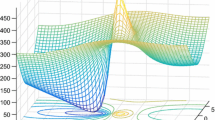Abstract
The L-curve criterion is often applied to determine a suitable value of the regularization parameter when solving ill-conditioned linear systems of equations with a right-hand side contaminated by errors of unknown norm. However, the computation of the L-curve is quite costly for large problems; the determination of a point on the L-curve requires that both the norm of the regularized approximate solution and the norm of the corresponding residual vector be available. Therefore, usually only a few points on the L-curve are computed and these values, rather than the L-curve, are used to determine a value of the regularization parameter. We propose a new approach to determine a value of the regularization parameter based on computing an L-ribbon that contains the L-curve in its interior. An L-ribbon can be computed fairly inexpensively by partial Lanczos bidiagonalization of the matrix of the given linear system of equations. A suitable value of the regularization parameter is then determined from the L-ribbon, and we show that an associated approximate solution of the linear system can be computed with little additional work.
Similar content being viewed by others
REFERENCES
M. L. Baart, The use of auto-correlation for pseudo-rank determination in noisy ill-conditioned least-squares problems, IMA J. Numer. Anal., 2 (1982), pp. 241–247.
Å. Björck, A bidiagonalization algorithm for solving large and sparse ill-posed systems of linear equations, BIT, 18 (1988), pp. 659–670.
L. Eldén, Algorithms for the regularization of ill-conditioned least squares problems, BIT, 17, (1977), pp. 134–145.
H. W. Engl and W. Grever, Using the L-curve for determining optimal regularization parameters, Numer. Math., 69 (1994), pp. 25–31.
W. Gander, Least squares with a quadratic constraint, Numer. Math., 36 (1981), pp. 291–307.
G. H. Golub, Some modified matrix eigenvalue problems, SIAM Review, 15 (1973), pp. 318–334.
G. H. Golub and G. Meurant, Matrices, moments and quadrature, in Numerical Analysis 1993, D. F. Griffiths and G. A. Watson, eds., Longman, Essex, England, 1994, pp. 105–156.
G. H. Golub and Z. Strakos, Estimates in quadratic formulas, Numer. Algorithms, 8 (1994), pp. 241–268.
G. H. Golub and U. von Matt, Quadratically constrained least squares and quadratic problems, Numer. Math., 59 (1991), pp. 561–580.
G. H. Golub and U. von Matt, Generalized cross-validation for large scale problems, J. Comput. Graph. Stat., 6 (1997), pp. 1–34.
G. H. Golub and U. von Matt, Tikhonov regularization for large scale problems, in Workshop on Scientific Computing, G. H. Golub, S. H. Lui, F. Luk, and R. Plemmons, eds., Springer, New York, 1997, pp. 3–26.
M. Hanke, Limitations of the L-curve method in ill-posed problems, BIT, 36 (1996), pp. 287–301.
P. C. Hansen, Analysis of discrete ill-posed problems by means of the L-curve, SIAM Review, 34 (1992), pp. 561–580.
P. C. Hansen, Regularization tools: A Matlab package for analysis and solution of discrete ill-posed problems, Numer. Algorithms, 6 (1994), pp. 1–35. Software is available in Netlib at http://www.netlib.org.
P. C. Hansen and D. P. O'Leary, The use of the L-curve in the regularization of discrete ill-posed problems, SIAM J. Sci. Comput., 14 (1993), pp. 1487–1503.
L. Kaufman and A. Neumaier, Regularization of ill-posed problems by envelope guided conjugate gradients, J. Comput. Graph. Stat., 6 (1997), pp. 451–463.
C. L. Lawson and R. J. Hanson, Solving Least Squares Problems, SIAM, Philadelphia, PA, 1995.
V. A. Morozov, On the solution of functional equations by the method of regularization, Soviet Math. Dokl., 7 (1966), pp. 414–417.
D. P. O'Leary and J. A. Simmons, A bidiagonalization-regularization procedure for large scale discretizations of ill-posed problems, SIAM J. Sci. Stat. Comput., 2 (1981), pp. 474–489.
C. C. Paige and M. A. Saunders, LSQR: An algorithm for sparse linear equations and sparse least squares, ACM Trans. Math. Software, 8 (1982), pp. 43–71.
C. R. Vogel, Non-convergence of the L-curve regularization parameter selection method, Inverse Problems, 12 (1996), pp. 535–547.
Author information
Authors and Affiliations
Rights and permissions
About this article
Cite this article
Calvetti, D., Golub, G.H. & Reichel, L. Estimation of the L-Curve via Lanczos Bidiagonalization. BIT Numerical Mathematics 39, 603–619 (1999). https://doi.org/10.1023/A:1022383005969
Issue Date:
DOI: https://doi.org/10.1023/A:1022383005969




